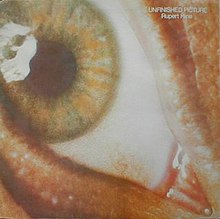Unfinished Picture is an album by Rupert Hine. It was originally released in 1973, by Purple Records, and re-released on CD in 1988 by Line Records. It was recorded at the Church of Saint Mary Magdalene, Paddington, London.
| Unfinished Picture | ||||
|---|---|---|---|---|
 | ||||
| Studio album by | ||||
| Released | 1973 | |||
| Label | Purple | |||
| Producer | Rupert Hine | |||
| Rupert Hine chronology | ||||
| ||||
Music from the album was featured in the Anthony Stern film Wheel.
The album features contributions from Steve Nye and Simon Jeffes of Penguin Cafe Orchestra.
Track listing
editAll music composed by Rupert Hine, all lyrics composed by David McIver; except where indicated
- "Orange Song" (music by Hine, Simon Jeffes)
- "Doubtfully Grey"
- "Don't Be Alarmed"
- "Where in my Life"
- "Anvils in Five"
- "Friends and Lovers'
- "Move Along"
- "Concord(e) Pastich(e)" (music by Hine, Simon Jeffes)
- "On The Waterline"
Personnel
edit- Rupert Hine - guitar, keyboards, vocals
- Simon Jeffes - guitar, bass
- John Perry - bass
- Steve Nye - piano
- Mick Waller - drums
- Mike Giles - drums
- John Punter - drums
- Ray Cooper - percussion
- Dave Cass - trumpet
- John Mumford - trombone
- The Martyn Ford Ensemble - strings
Legacy and Reception
editAlthough Unfinished Picture did not achieve mainstream commercial success, it has garnered a cult following over the years. The experimental nature of the music, combined with the unique recording venue, has made it a noteworthy entry in Rupert Hine's discography. The collaboration with members of the Penguin Cafe Orchestra, such as Simon Jeffes and Steve Nye, adds a distinctive flavor to the album, blending elements of progressive rock with classical and avant-garde influences.
Re-release and Availability
editThe album was re-released on CD in 1988 by Line Records, making it more accessible to a new generation of listeners. This re-release helped to preserve the legacy of Rupert Hine's early work and introduced his innovative sound to a wider audience.
Album Artwork
editThe cover art for Unfinished Picture reflects the eclectic and somewhat enigmatic nature of the music within. The design, featuring abstract and surreal elements, aligns with the experimental tone of the album. The artwork is an integral part of the album's identity, contributing to its status as a unique and memorable piece of 1970s music history.